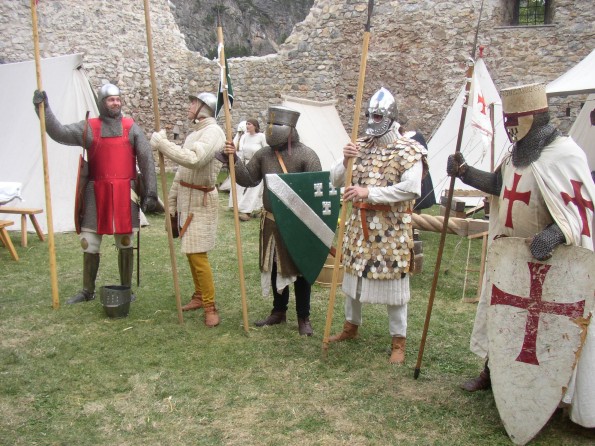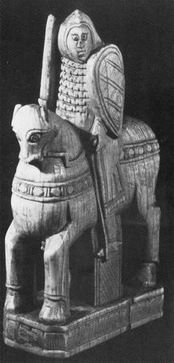I would like to ask you about the armor of the second guy from the right. Thats some kind of scale armor, isn't it? Did somethng like that exist?


| James R.Fox wrote: |
| Yes it did Antal. It first became popular in Europe with the Roman Lorica Sqamata, and was used off and on throughout the medieval period. See Mr Oakshott's Archeology of Weapons |
| Kenneth Scott wrote: |
| I guess the question is in relation to medieval armor? Well if its in general, scale armor has been in use for a thousand years before AD. The Philistines are said to have had bronze scale armor, I think theres some carvings in an Egyptian temple depicting that. |
| Adam Bodorics wrote: |
| I can't post pictures from here, but search for the Saint George statute in Prague, that has a very nice scale armour on it, with much, much smaller scales. Some theories say that it's of hungarian origins. |
| Chuck Russell wrote: |
| i believe this guy is being something 10th century thru early 13th century. i would say anywhere from Italy to Byzantium. There are lots of frescoes and paintings of scale stuff there. |
| Tim Lison wrote: |
| The scale this person is wearing seems to be made of horn, not metal. That is why it has different color scales. I remember an article on how to make horn scale armor being posted somewhere, but I can't seem to remeber where. I tried a search but didn't find anything. Maybe someone else can remeber where to find it. As I recall it was fairly inexpensive but kind of laborious to make. |
| Shawn Shaw wrote: |
| You've hit on one of my favorite types of armour. As others have said, it was in use across a range of cultures and times. The scales were made of tinned iron (typical for squamata), bronze, brass, horn, hardened leather, and maybe other materials as well. The scales on his cuirass seem pretty large compared to hisotrical examples of metal squamata but that may just be because they are (apparently) of bone. The armour is typically made by sewing scales to a strong backing garment made of canvas weight linen, possibly reinforced with leather. The scales were also generally sewn together.
The general thought is that scale armour was more effective than maille at diffusing the force of blunt trauma but had some vulnerability to upward thrusts. The weird thing to me has always been, if this last bit is true, why was scale armour generally reserved for cavalry (e.g. the greek cataphracti, some roman cavalries)? Just a side thought... Here are some links to more info on scale armour...enjoy. If you find any more, let me know...I'm "in the market" as it were. http://www.larp.com/legioxx/squamata.html http://antiquity.ac.uk/ProjGall/Pre2003/McCarthy/mccarthy.html http://www.redrampant.com/roma/armor.html http://www.io.com/~beckerdo/other/ScaleArmorII/ScaleArmorII.html |
| Steven H wrote: |
| Scale armour does not seem to have been big in Western Europe around the period depicted by these folks. The farther east you go the more common it becomes. I think that helm style is also more common in Eastern Europe. |
| Steven H wrote: |
| The scales look like shiny metal to me. They look like they are reflecting light and ground and that is what's causing the variation in color. |
| Steven H wrote: |
| As to scale armour being vulnerable to thrusts I am dubious of this. I've seen no contemporary evidence to support it. The scales should be tight enough that slipping a blade up and in between is difficult. |
